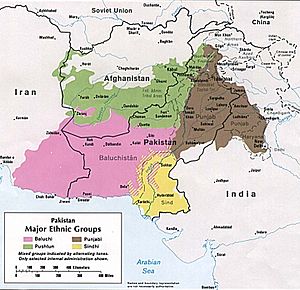Ethnic groups of Pakistan facts for kids
Pakistan is a country with many different groups of people. These groups are called ethnic groups. They often have their own languages and traditions. About 98% of the languages spoken in Pakistan come from a big language family called Indo-Iranian. This family includes languages like Urdu, Punjabi, Pashto, and Sindhi. Most of these languages are written using a script similar to Arabic and Persian.
People in Pakistan belong to various groups. These include those who speak Indo-Aryan languages and those who speak Iranian languages. There are also smaller groups like the Burusho and Brahui speakers. The largest ethnic groups in Pakistan are the Punjabis, Pashtuns, Sindhis, Seraikis, Muhajirs, and Balochs.
Here are the main ethnic groups and their estimated sizes (from 2009):
- Punjabis: 40.20% (about 70.7 million people)
- Pashtuns: 19.80% (about 35.2 million people)
- Sindhis: 14.1% (about 24.8 million people)
- Seraikis: 10.53% (about 14.8 million people)
- Muhajirs: 7.57% (about 13.3 million people)
- Balochs: 3.57% (about 6.3 million people)
- Others: 4.66% (about 11.1 million people)
Smaller ethnic groups are mostly found in the northern parts of Pakistan. These include Kashmiris, Kalash, Burusho, Brahui, Khowar, Shina, and Turwalis. Sometimes, people from the Potohar Plateau in Northern Punjab are counted separately from Punjabis.
Hindkowan People and Language
Hindkowans is a term used for people living in the Hazara Division of Khyber Pakhtunkhwa province. This area is between the Pashtun regions, Northern Punjab, and Kashmir. The Hindko language is mostly spoken here.
It is important to know that "Hindkowan" describes a language group, not a single ethnic group. The people in the Hindko-speaking areas come from many different backgrounds. These include Pashtun settlers like the Yusufzai and Tanoli. There are also people from Punjabi and Kashmiri tribes. Other groups include the Awan, Mughal, Turk, and Gujar.
While the term usually refers to people in Hazara (especially Abbottabad, Haripur, and Mansehra districts), it also includes Hindko-speaking people in other cities. These cities are Peshawar, Kohat, and Dera Ismail Khan in Khyber Pakhtunkhwa. It also includes Dera Ghazi Khan and Mianwali in Punjab.
Hazara People
The Hazara are an ethnic group who speak Persian. They are not to be confused with the Hazara region. Most Hazara people in Pakistan live in Quetta, Balochistan. A smaller number, who are refugees from Afghanistan, live near Islamabad and a few in Peshawar. They are related to people from Eurasia and the Uyghur people. There are believed to be over 200,000 Pakistani Hazaras. Afghan refugee Hazaras in Pakistan are estimated to be between 10,000 and 12,000.
Makrani People
The Makranis live along the Makran coast in Balochistan, Pakistan, and parts of Iran. They are people of African descent. Their ancestors were brought to this region by Arab traders long ago, from parts of eastern Africa where Bantu languages are spoken.
Tajik People
The Tajiks are a Persian-speaking group. Their traditional homelands are in countries like Afghanistan, Tajikistan, and Uzbekistan. Some Tajiks also live in northern Pakistan and western China. In Pakistan, Tajiks live among other groups from Central Asia, such as the Dardic and Chitrali people. It is estimated that there are between 100,000 and 125,000 Tajiks in Pakistan.
Balti People
The Baltis are an ethnic group with Tibetan roots. They also have some Dardic heritage. They mainly live in Gilgit-Baltistan, Pakistan, and Ladakh. In Pakistan, many Baltis also live in big cities like Lahore, Karachi, and Islamabad/Rawalpindi. The Balti language is part of the Tibetan language family. It is a dialect of Ladakhi.


